|
Getting your Trinity Audio player ready...
|
The European Securities and Markets Authority (ESMA) has set strict deadlines for digital asset firms to restrict non-compliant stablecoins under the European Union’s Markets in Crypto-Assets (MiCA) regulations by “no later than” March 31.
In a January 17 statement, ESMA—the regulator charged with overseeing the MiCA regulations—urged crypto asset service providers (CASPs) to take swift action to restrict or delist stablecoins that are not compliant with MiCA.
The full MiCA regulations related to CASPs came into force on December 30, 2024, with the provisions relating to stablecoins coming into play earlier, on June 30. The stablecoin provisions of MiCA went with a host of new obligations for issuers and offerors of asset-referenced tokens (ARTs)—stablecoins that purport to maintain a stable value by referencing another value or right—and e-money tokens (EMTs), stablecoins pegged to a fiat currency.
Only stablecoins issued by entities that receive authorization from a National Competent Authority (NCA)—a member state’s relevant regulatory body—can be offered in the EU.
In its latest update, ESMA clarified that restrictions on the existing services are expected to be completed by the end of January 2025. However, to allow EU investors to liquidate or convert their position in non-MiCA stablecoins, CASPs may maintain digital asset services for these products on a “sell only” basis until the end of Q1 2025 (March 31).
The EU finance watchdog urged CASPs to act “promptly,” warning that delay resulting in “sudden actions to align with MiCA” could potentially lead to “disorderly crypto-assets markets.”
It added that “to mitigate potential disruptions and ensure a smooth and orderly transition, NCAs should ensure compliance by CASPs regarding non-compliant ARTs or EMTs as soon as possible and no later than the end of Q1 2025.”
This puts the onus on regulatory authorities—the NCAs—of the EU’s 27 member states to enforce compliance with the new rules.
ESMA did not specify which stablecoins and issuers are currently non-compliant and thus should be restricted, but the industry’s largest stablecoin issuer by market cap, Tether’s USDT, is likely to be a notable candidate due to its apparent reticence to apply for MiCA authorization.
Tether: To delist or not to delist
Uncertainty over whether Tether would apply for authorization led the Coinbase exchange (NASDAQ: COIN) to delist the stablecoin in mid-December. Other major exchanges have adopted a more cautious approach, with Binance and Crypto.com continuing to list USDT for EU clients—for the moment.
Tether has not officially revealed whether or not it intends to get, or already is, compliant with the MiCA regulations. However, the issuer recently discontinued support for Euro stablecoin (EURT), citing objections to specific MiCA provisions.
“This decision aligns with our broader strategic direction, considering the evolving regulatory frameworks surrounding stablecoins in the European market,” Tether said in November last year. “Until a more risk-averse framework is in place—one that fosters innovation and offers the stability and protection our users deserve—we have chosen to prioritize other initiatives.”
Other sources have also suggested that Tether does not hold or intend to apply for the necessary MiCA license.
In a January 18 post on LinkedIn, Juan Ignacio Ibañez, General Secretary of the regulation advisory group MiCA Crypto Alliance, advised CASPs to delist “non-compliant assets like USDT” in order to comply with their new regulatory obligations.
EU stablecoin rules
In terms of this new obligation, the MiCA framework was designed to come into effect in stages. The stablecoin provisions took effect first, on June 30, followed by the remaining requirements related to CASPs, which came into force at the end of December 2024.
The key new provisions for stablecoins include:
- Requiring issuers of ARTs and EMTs to be authorized by the competent authority of the member state, usually the national central bank or financial supervisory authority, and to publish a white paper containing information on the relevant token for investors;
- New conduct and governance requirements around marketing, disclosure of information, and dealing with conflicts of interest;
- Prudential requirements to ensure sufficient liquidity and the ability to meet redemption requests; and
- Issuance and public offering of stablecoins are restricted without authorization and the publication of a “white paper” approved by the National Competent Authority (NCA).
Issuers of EMTs were also henceforth required to comply with existing EMD 2 obligations—the second electronic money directive, developed to align EU requirements and supervise electronic money institutions—which include informing authorities on how they safeguard funds received in exchange for e-money issued, ensuring they can “redeem at any moment and at par value” the monetary value of the e-money held, e-money institutions must hold initial capital of not less than EUR 350 000 at the time of authorisation, and e-money institutions are subject to anti-money laundering legislation.
Some ARTs or EMTs may also be considered “significant” due to their size or other factors and, as a result, may present an increased systemic risk. For these, MiCA added measures comparable with the regime applied to classify global systemically important banks, such as enhanced capital and liquidity requirements, stricter governance frameworks and intensified stress testing obligations.
The European Banking Authority (EBA) has supervisory responsibilities for issuers of stablecoins that are deemed to fall into this category, enforcing more rigorous stress testing and oversight.
Under the MiCA regulation, a stablecoin is classified as significant or systemic if it meets any three of seven criteria, such as having more than €5 billion (US$6.28 billion) in reserves, over 10 million users, or processing over €500 million ($616 million) daily. Other considerations include whether it’s interconnected with the financial system and if it’s used for payments on a global scale.
Another factor playing into Tether’s reticence to apply for EU authorization could be that USDT would almost certainly fall within the category of systemically significant and thus be subject to the additional requirements of the EBA—on top of those that come with MiCA.
Watch Centi: Bridging digital money and traditional banking

 08-08-2025
08-08-2025 





